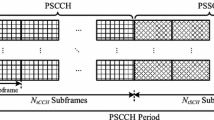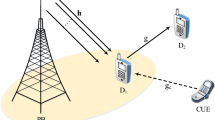Abstract
As the demands for efficient distributed device-to-device (D2D) communications increase, signal-to-interference ratio (SIR)-based multiple access (SBMA) technique has been proposed. By enabling SIR-aware multiple access control in distributed D2D communication, SBMA can improve utilization of the shared wireless medium in comparison with the conventional carrier sense multiple access technique. However, SBMA suffers from the cascade yielding problem which adversely affects the performance gain expected from SBMA. Cascade yielding is caused due to the limited knowledge available to each device about the medium access decisions of the neighboring devices. In order to reduce this problem, this paper enhances SBMA by taking into account the yielding relationships between neighboring devices during medium access decisions. The yielding relationships enable each device to more precisely estimate the SIRs and hence more effectively determine medium accessibility. Our simulation results show that the enhanced SBMA can allow more devices to simultaneously access the shared medium and improve the overall performance of D2D communications.










Similar content being viewed by others
Notes
K is defined to scale the power of IPE signal within allowable transmission power range.
Note that home-grown simulators are commonly used for evaluating the performance of D2D communications [21].
References
Doppler, K., Rinne, M., Wijting, C., Ribeiro, C., & Hugl, K. (2009). Device-to-device communication as an underlay to LTE-advanced networks. IEEE Communications Magazine, 47(12), 42–49.
Lei, L., Zhong, Z., Lin, C., & Shen, X. (2012). Operator controlled device-to-device communications in LTE-advanced networks. IEEE Wireless Communications, 19(3), 96–104.
3GPP. (2013). Feasibility study for proximity services (ProSe). 3GPP TR 22.803, v12.2.0.
3GPP. (2013). Group communication system enablers for LTE (GCSE\_LTE) (Release 12). 3GPP TS 22.468, v12.0.0.
3GPP. (2011). Key drivers for LTE success: Service evolution. 3GPP TSG SA seminar.
3GPP. (2011). 3GPP study item discussion on LTE-direct device-to-device discovery and communication, key drivers for LTE success: Service evolution. 3GPP S1–112016.
3GPP. (2011). Study on LTE-direct. 3GPP S1–112017.
IEEE 802.15 WLAN TG 8. (2013). Peer aware communications. http://www.ieee802.org/15/pub/TG8.html. Accessed 27 Nov 2013.
Chhaya, H. S., & Gupta, S. (1997). Performance modeling of asynchronous data transfer methods of IEEE 802.11 MAC protocols. Wireless Networks, 3(3), 217–234.
Wu, X., Tavildar, S., Shakkottai, S., Richardson, T., Li, J., Laroia, R., et al. (2013). FlashLinQ: A synchronous distributed scheduler for peer-to-peer ad hoc networks. IEEE/ACM Transactions on Networking, 21(4), 1251–1227.
Wu, X. (2010). FlashLinQ: A clean slate design for ad hoc networks. Qualcomm presentation. http://scenic.princeton.edu/ppt/FLQ_Edge.ppt. Accessed 27 Nov 2013.
IEEE Std 802.11-2012. (2012). Part 11: Wireless LAN medium access control (MAC) and physical layer (PHY) specifications. IEEE.
Kim, D. K., & Adachi, F. (2001). Theoretical analysis of reverse link capacity for an SIR-based power-controlled cellular CDMA system in a multipath fading environment. IEEE Transactions on Vehicular Technology, 50(2), 452–464.
Lu, Z., & Zarki, E. Z. (1994). SIR-based call admission control for DS-CDMA cellular systems. IEEE Journal on Selected Areas in Communications, 12(4), 639–644.
Dai, J. G., & Prabhakar, B. (2000). The throughput of data switches with and without speedup. In Proceedings of IEEE INFOCOM 2000, (pp. 556–564).
Lin, X., & Shroff, N. B. (2005). The impact of imperfect scheduling on cross-layer rate control in wireless networks. In Proceedings of IEEE INFOCOM 2005, (pp. 1804–1814).
Joo, C., Lin, X., & Shroff, N. (2009). Understanding the capacity region of the greedy maximal scheduling algorithm in multihop wireless networks. IEEE/ACM Transactions on Networking, 17(4), 1132–1145.
Cho, C., Kang, J. W., & Kim, S.-H. (2013). Multi-level thresholding for reducing cascade yielding of FlashLinQ link scheduling. In Proceedings of ACM ICUIMC 2013, (pp. 1–5).
Wu, X., Li, J., Tavildar, S., & Richardson, T. (2011). Apparatus and method of generating and maintaining hybrid connection identifications (IDS) for peer-to-peer wireless networks. US Patent, US 8,005,091 B2.
Laroia, R., Li, J., Richardson, T., Wu, X., & Jovicic, A. (2011). Methods and apparatus for use in peer to peer communications devices and/or systems relating to rate scheduling, traffic scheduling, rate control, and/or power control. US Patent, US 8,041,375 B2.
Asadi, A., Wang, Q., & Mancuso, V. (2014). A survey on device-to-device communication in cellular networks. IEEE Communications Surveys & Tutorials, PP(99), 1–18.
ITU-R. (2009). Guidelines for evaluation of radio interface technologies for IMT-Advanced. Report ITU-R M.2135-1.
3GPP. (2012). Evolved universal terrestrial radio access (E-UTRA); radio frequency (RF) system scenarios. 3GPP TR 36.942, V11.0.0.
Jain, R. (1991). The art of computer systems performance analysis: Techniques for experimental design, measurement, simulation and modeling. New York: Wiley.
Acknowledgments
This work was partially supported by Samsung Electronics and by the National Research Foundation of Korea (NRF) grant funded by the Korean government (MSIP) (2014R1A5A1011478).
Author information
Authors and Affiliations
Corresponding author
Rights and permissions
About this article
Cite this article
Bae, S.J., Gu, J., Hasan, S.F. et al. SIR-based multiple access with cascade yielding avoidance for distributed device-to-device communications. Wireless Netw 21, 1079–1091 (2015). https://doi.org/10.1007/s11276-014-0839-2
Published:
Issue Date:
DOI: https://doi.org/10.1007/s11276-014-0839-2




